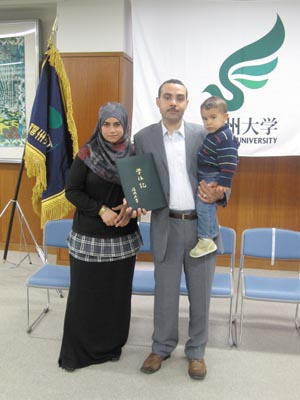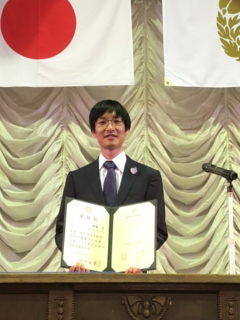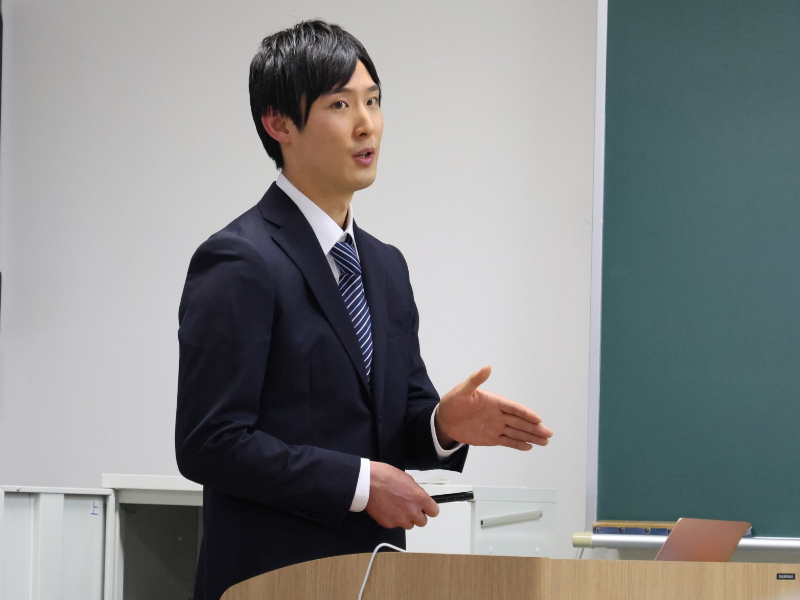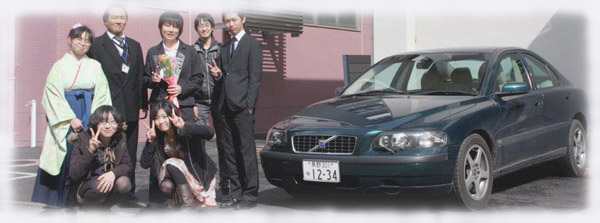博士号取得者

(1) 加藤 めぐみ / 2006年9月27日 博士 (工学) 論文提出審査 [乙] ・・・ 主論文 7編

Microinsemination and its application to transgenesis in the rats
(ラットにおける顕微授精技術の開発と外来遺伝子導入法としての利用に関する研究)
博士論文審査委員会: 主査; 保地 / 副査; 天野・小島・関口・藤井

(ラットにおける顕微授精技術の開発と外来遺伝子導入法としての利用に関する研究)
精子の顕微授精技術 (ICSI) は今や受精生理の研究手法にとどまらず, ヒト男性不妊の治療法の一つとしても実用化されている. 実験小動物では1995年にマウスのICSI産仔獲得が報告され, さらに未成熟な精細胞である円形精子細胞や伸張精子細胞を用いた顕微授精 (ROSIおよびELSI) による産仔獲得も可能になっている. また近年, 精子をベクターとして利用し, ICSIを介して外来遺伝子を導入したトランスジェニック (Tg) マウスも作製されている. しかしマウス同様に実験小動物として重要な役割を担うことが期待されるラットでは, いずれの顕微授精技術も確立されていない. 本研究ではラットにおける顕微授精技術の開発を進め, さらに外来遺伝子導入法としての利用性を検討した (緒論:第1章). 同じ哺乳類でも精子頭部のサイズ・形状には違いが認められる. とくにラット精子の頭部は釣り針状の特殊な形をしているため, ICSIで用いる注入ピペットは径の大きなものに頼らざるを得ず, 卵子へのダメージが大きくなってしまうことが問題であった. 試行錯誤の結果, 径の細いピペットを使用して注入操作そのものを変更することにより, ICSI由来の産仔を得ることに成功した. 続いて不妊Tgラット系統 のICSIによる維持へと展開したが, 精子頭部が形成不全だったこの症例には改良ICSI法は機能しなかった (第2章). そこで円形精子細胞を顕微授精するROSI技術の開発を試みた. 齧歯類の円形精子細胞は卵子を活性化するのに十分なSOAF (精子由来卵子活性化因子) 活性を持たないため, ROSI卵子には活性化を施す必要がある. マウスでは2.5〜10 mMの塩化ストロンチウムが活性化誘起試薬として用いられているが, ラットにおける至適濃度は1.25 mMであり, この条件で活性化させることによってROSI胚に由来する産仔の獲得 (=不妊Tg ラット系統の救済) に成功した. さらに, その後の検討でROSI胚の個体発生には直流パルスと6-DMAPの併用処理によって活性化した方が効果的であることも判明した
(第3章). 凍結乾燥した精子は常温で保存できるものの運動性を完全に失ってしまうという問題があったが, ICSI技術の普及によりこの保存法の有効性が見直された. マウスとウサギですでに報告された成功例に続き, 我々も凍結乾燥ラット精子のICSIに由来する正常産仔を得ることに成功した. また精子尾部の切断・除去に超音波破砕装置を用いることによって産仔率が改善されることも明らかにした (第4章). ここまでに確立したラットの顕微授精技術をさらに有効にするため, 外来遺伝子の導入法としての利用を試みた. EGFP遺伝子を精子頭部, あるいは伸張精子細胞に付着させ, 顕微授精によって作製した産仔におけるEGFP遺伝子の導入効率を調べた. 顕微授精胚の体外での発生率と蛍光タンパク発現率から, ICSIでは0.5 µg/ml, ELSIでは5 µg/mlがEGFP 遺伝子の最適処理濃度であるとわかった. 顕微授精 (ICSI, ELSI) を介してTg ラットが作製できると証明でき, 外来遺伝子の導入効率は一般的に用いられている前核注入法と同等か, それ以上であることもわかった (第5章). このうちICSI-Tg法におけるTgラット作製効率に影響を及ぼす要因について検討したところ, 外来DNAに曝す前に精子に超音波処理を施しておくことが有効だった. また, あらゆる系統のラットにこのICSI-Tg法が適用でき, その中でもSD系がもっとも優れていた. さらに, BACやYACを含む数百キロベースの鎖長をもつ外来DNAにも適用可能なことも明らかになった (第6章). Tg動物の作製効率を改善する試みに関し, リコンビナーゼ-A プロテイン (RecA) で被覆したssDNAを用いる前核注入法の有効性がブタとヤギで報告されている. また, マウスではRecA処理した外来DNAを精子に付着させてICSI-Tgを行い, 高い効率で Tg マウスが作製できることが報告された. そこで, RecA処理した外来DNAを用いてTgラット作製効率が改善されるか否かを検討したが, その有効性は認められなかった (第7章). 以上, 精子および精子細胞に由来する産仔の獲得を通してラットの顕微授精技術を確立したこと, そしてその顕微授精技術がTgラットの効率的作製に貢献できたこと, を結論とする (結論:第8章).
博士論文審査委員会: 主査; 保地 / 副査; 天野・小島・関口・藤井
(2) Hany L.H.A. ABDALLA / 2009年9月30日 博士 (農学) 課程修了審査 [甲] ・・・ 主論文 3編

Intracytoplasmic injection of freeze-dried bull spermatozoa
(凍結乾燥ウシ精子の卵細胞質内顕微注入に関する研究)
博士論文審査委員会: 主査; 保地 / 副査; 志田・片岡・塩見・外部審査委員; 佐伯 (近畿大)

(凍結乾燥ウシ精子の卵細胞質内顕微注入に関する研究)
Freeze-drying has been proposed as an alternative method for sperm preservation. Since freeze-dried (FD) spermatozoa after rehydration loose their motility that is essential requirement to complete the physiological fertilization, relatively difficult and specialized technique as intracytoplasmic sperm injection (ICSI) must be applied to use the FD sperm. However, the low efficacy of ICSI technique in cattle constitutes a species-specific obstacle against the successful application of FD bull spermatozoa. Moreover, the characteristics of FD bull sperm to trigger the early post-fertilization events (induction of calcium oscillations and oocyte activation) and the dynamics of epigenetic reprogramming in the FD sperm-derived pronuclear zygotes (active demethylation of paternal genome) have not been well-understood. In the present study, the contributions of the FD bull sperm to oocyte activation, paternal genome demethylation and embryonic development were investigated. In Chapter-1, the basic background and factors influencing the efficacy the freeze-drying process, the history and achievements of freeze-drying in mammalian spermatozoa, as well as the current problems facing the bovine ICSI were described, along with the goal of the present study.
In Chapter-2, bull spermatozoa freeze-dried and stored for one year at +25, +4 or -196 C were microinseminated into ovulated mouse oocytes to evaluate their ability for inducing intracellular calcium oscillations, and into in vitro-matured bovine oocytes to evaluate the resumption of meiosis. The original freezing-drying protocol included 14 h-primary dehydration process at 0.37 hPa followed by 3 h-secondary dehydration process at 0.001 hPa. Repetitive increases in the intracellular calcium concentration were recorded in the majority of injected mouse oocytes, with exception of a few oocytes injected with FD sperm stored at +25 or +4 C that exhibited a single increase or no response (non-oscillated). The proportion of oocytes oscillated with high frequency (>10 spikes per hour) was higher in the control oocytes injected with freeze-thawed (FT) sperm than those in the oocytes injected with FD sperm. After homogenous ICSI, the proportions of bovine oocytes resuming meiosis and developing to the pronuclear stage (complete activation) were higher in the control group than those in all the FD groups. Thus, the ability of bull spermatozoa to induce frequent intracellular calcium spikes in mouse oocytes was impaired by the process of freeze-drying, without differences among storage at +25, +4 or -196 C, probably resulting in a lower proportion of bovine oocytes that resumed meiosis and/or developed to the pronuclear stage.
In Chapter-3, demethylation dynamics of paternal genome in pronuclear-stage bovine zygotes produced by in vitro fertilization (IVF), or intracytoplasmic injection of FT and FD spermatozoa (stored for one year at +4 or -196 C) were investigated. In conventional IVF-derived zygotes, the overall average of the relative methylation (RM; male/female) significantly decreased from 0.92 at 8 h post insemination (hpi) to 0.69 at 10 hpi without any additional decrease at 14 and 18 hpi. This was accompanied with higher proportions of zygotes showing RM<0.6 at 10, 14 and 18 hpi, compared to the proportion at 8 hpi. The overall averages of the RM in the FT-ICSI derived zygotes (0.79 and 0.66 at 6 and 12 hpic, h post ICSI; respectively) were similar to those in the corresponding IVF-derived zygotes (8 and 14 hpi), but higher proportion of the 6 hpic zygotes showed RM<0.6 compared to the 8 hpi zygotes. The proportions of the FD-ICSI derived zygotes at 12 hpic showing RM<0.6 were higher than that in the FT-ICSI derived zygotes. Thus, bovine paternal genome rapidly demethylated within 10 h after IVF and 6 h after ICSI, and at least the freeze-drying and/or the storage process have no adverse effect on demethylation of the paternal genome. The demethylation extent in pronuclear-stage bovine zygotes was moderate with RM=0.4~0.6.
In Chapter-4, in vitro production of bovine blastocysts from FD sperm-derived zygotes was attempted. As preliminary parts of this experiment, effects of oocyte centrifugation to ensure sperm injection, sperm pretreatment with dithiothreitol to reduce the disulfide bonds, and application of supplementary regimens for oocyte activation on the blastocyst yields from ICSI oocytes were investigated. Only oocyte activation regimen among these factors contributed to improve the bovine ICSI technique as below. Following ICSI, oocytes were treated with ionomycin, ethanol, ionomycin followed by ethanol, ionomycin followed by cycloheximide, or ionomycin followed by 6-dimethylaminopurine. Activating the ICSI oocytes with ionomycin plus ethanol improved the blastocyst yield (29-30%) comparing to the non-treated oocytes (12%), but the other regimens did not (9-18%). None of the regimens have any adverse effect on the quality of the blastocysts regarding the total cell number or the proportion of the inner cell mass cells. Therefore, the new activation regimen composed from two triggers for single calcium increase was applied to the oocytes injected with FD sperm. The FD sperm were prepared either by the original 2-setp freezing-drying protocol or the shorter 1-step protocol without the secondary dehydration process, and stored for 1-7 days at +4 C. The cleavage rates of FD-ICSI oocytes (34-43%) were ~50% lower than that of FT-ICSI oocytes (68%). Regardless the protocol for FD sperm preparation, the blastocyst development rate after FD-ICSI (1-2%) was much lower than that after the control FT-ICSI (21%), thus further improvement of the freeze-drying protocol for bull spermatozoa is required. In Chapter-5, a conclusive summary for this thesis is described. Freeze-drying protocol employed here slightly reduced the ability of the sperm to induce calcium oscillations and resumption of meiosis, but it had no adverse effect on the active demethylaton dynamics of paternal genome during the early stage after fertilization. However, bull sperm freeze-dried by this protocol contributed very little to the embryonic development to the blastocyst stage, even after improvement of blastocyst yield from ICSI oocytes by applying exogenous activation stimuli with ionomycin and ethanol. Therefore, the conditions during the freeze-drying process, that were found practical originally in small rodents, need to be optimized for bull spermatozoa.
博士論文審査委員会: 主査; 保地 / 副査; 志田・片岡・塩見・外部審査委員; 佐伯 (近畿大)
(3) 岩山 広 / 2011年3月24日 博士 (学術) 論文提出審査 [乙] ・・・ 主論文 5編

高度生殖補助医療技術を適用したヒト不妊治療に関する研究
博士論文審査委員会: 主査; 保地 / 副査; 志田・塚田・阿部康・外部審査委員; 吉澤 (宇都宮大)

不妊症に悩むカップルは多く, 患者の治療に手を貸す各クリニックは有用な情報を共有し, 最善の技術を提供するよう努めなければならない. 本研究では個々の高度生殖補助医療技術 (ART) の精度を高めるため, 患者に対して十分なインフォームドコンセントを実施したうえで, ピエゾマイクロマニピュレーターを用いた顕微授精 (ICSI), マイクロウェル培養法の臨床応用, 透明帯硬度の非侵襲的定量, そして拡張胚盤胞のガラス化保存に先立つ胞胚腔の人工収縮処理, についてそれらの有用性を検討した (緒論:第1章). ICSIはマイクロピペットを卵細胞質に穿刺するという侵襲的な操作を伴い, 一定の割合で卵子は変性し, 細胞死に至る. まず最初に, ピエゾICSI時の卵細胞膜の伸展性が胚盤胞への発生能, および着床能に及ぼす影響について検討した. 伸展性は, 穿刺点より直径で75%未満の伸展性を示し, ピエゾパルスの適用前に卵細胞膜が穿破された場合を「低伸展性卵子」, 一方, 75%以上の伸展性を示し, ピエゾパルスを適用して卵細胞膜を穿破する場合を「高伸展性卵子」と定義した. ICSI後の「低伸展性卵子」の生存率は,「高伸展性卵子」に比較して有意に低下したが, 生存卵子からの胚盤胞発生率には両者の間に有意差は認められなかった. さらに多変量解析により,着床において卵細胞膜の低伸展性は危険因子となり得ることが明らかとなり, 妊娠の可能性が高い移植胚を選択するうえでの基準の1つとして考慮されるべき特徴であると示唆された (第2章).
胚盤胞までの体外培養が一般的となった現在においても, 胚盤胞が得られずに移植がキャンセルとなる症例は少なくない. 胚の培養密度は体外発生能に影響を及ぼすが, ヒトの不妊治療においては単一あるいは少数胚での培養を強いられることがよくある. そこで次に, 単一胚培養において最適な微小環境を提供できるマイクロウェル培養法による胚盤胞発生能を, 従来のマイクロドロップ培養法と比較した. 胚盤胞発生率および臨床妊娠率において「マイクロウェル群」の有用性は認められなかったものの, 症例追加によって発生した胚盤胞に占める拡張胚盤胞の割合は「マイクロウェル群」において有意に改善されることがわかった. 移植胚の選別のために, 胚の個別化による連続的かつ集約的評価が可能となる本法の臨床応用が期待される (第3章). 透明帯の硬度は, 酵素に対する溶解性などを指標に侵襲的に求められてきた. それゆえ, 孵化補助 (AH) の適応基準として透明帯硬度が議論されたことはない. そこで, 偏光顕微鏡により取得できる複屈折パラメーター (レターダンス [R], 厚さ [T], およびレターダンスと厚さの積 [R×T]) が透明帯硬度の非侵襲的定量の指標となるかどうかを検討した. まず, 透明帯の酵素溶解時間 (化学的硬度) とR, TおよびR×T値の関係を, 次に, 透明帯にフロリナートを顕微注入して擬似拡張を誘発したときの透明帯の最大伸展率 (物理的硬度) と破綻部位のR, TおよびR×T値の関係を調べたところ, それぞれR×T値との間に高い相関が認められた. 透明帯の複屈折特性であるR×T値を用いれば, ヒト受精卵の透明帯の化学的および物理的硬度を非侵襲的に評価することが可能であり, AH適用基準や適用位置情報を提供しうる (第4章).
子宮内膜の調節周期において凍結融解胚盤胞を移植すれば高い着床率が期待できるため, 今日のARTにおいて重要な治療法の1つとなっている. 一方, 拡張胚盤胞の胞胚腔内に多量に貯留する水分の存在は氷晶形成の危険性を増大させ, 凍結胚の蘇生率に影響を及ぼしうる. そこで, 拡張胚盤胞を超急速ガラス化保存する前に, レーザーパルス照射あるいは高張シュクロース溶液への曝露によって胞胚腔の人工収縮を誘起し, 加温後の胚盤胞の生存率および着床率を調べた. 人工収縮を誘起した2実験区と無処理 (対照) 区のいずれにおいても, 加温胚の生存率は高率であった.着床率については,「レーザー処理区」は「シュクロース処理区」と同等であったが, 「無処理区」と比較すると有意に改善されていた. また, 速やかに再拡張した胚盤胞の割合は人工収縮を施した2実験区において無処理区よりも高くなる傾向にあり, 早期に再拡張した胚盤胞は高い着床能を持つこともわかった (第5章). ARTを用いた不妊治療において, 患者にとって身体的, 精神的, かつ経済的に負担の少ない治療戦略とは, 最小回数の採卵から多くの移植機会を得て, 挙児につなげることである. すなわち, (1) 安全な卵巣刺激, (2) 確実な受精成立, (3) 高率な胚盤胞の発育, (4) 蘇生率の高い凍結保存, (5) 高い確率で着床が期待できる移植胚の選別, そして (6) 子宮内膜の調節周期における単一の胚盤胞移植, という「胚盤胞の凍結融解移植プログラム」を高い技術水準で施行されることが望ましい. このようなART利用の不妊治療の実践のため, 個々の基盤技術の精度を高める臨床研究とその結果の公表, さらには情報共有が, 不妊に悩む多くの夫婦に福音をもたらす一助となる (総括:第6章).
博士論文審査委員会: 主査; 保地 / 副査; 志田・塚田・阿部康・外部審査委員; 吉澤 (宇都宮大)
(4) In-Sul HWANG / 2013年9月24日 博士 (農学) 課程修了審査 [甲] ・・・ 主論文 2編

Microtubule assembly and in vitro development of vitrified bovine oocytes
after in vitro fertilization
(ガラス化保存したウシ卵母細胞における体外受精後の微小管形成ならびに体外発育に関する研究)
博士論文審査委員会: 主査; 保地 / 副査; 下坂・片岡・堀江・外部審査委員; 菊地 (農研機構)

after in vitro fertilization
(ガラス化保存したウシ卵母細胞における体外受精後の微小管形成ならびに体外発育に関する研究)
Successful pregnancies or birth of offspring derived from frozen-thawed oocytes have been reported in several mammalian species a few decades ago, with relatively low developmental rates. Application of vitrification, instead of the conventional two-step freezing, improved the efficacy of oocyte cryopreservation, especially in mice and humans. Various cryodevices have been developed to accelerate the cooling rate. However, vitrification of oocytes from large domestic species enriched with cytoplasmic lipid droplets still requires substantial improvement. During the vitrification procedures, oocytes can be damaged because of their large cell size and low permeability of water and cryoprotective agent (CPA). Moreover, depolymerization of microtubules induced by CPA treatment and cryopreservation resulted in meiotic spindle disassembly and chromosome misalignment. Treatment with CPA induced a transient rise of intracellular free calcium level, premature exocytosis of cortical granules, and hardening of zonae pellucidae. The objective of the present study was to investigate the effect of vitrification and warming on revivability of in vitro-matured bovine oocytes (Chapter-I).
A centrosome is composed of a pair of centrioles surrounded by the pericentriolar materials, such as gamma-tubulin, centrin and pericentrin, and acts as microtubule-organizing center (MTOC). In cattle, a sperm brings a centrosome into an oocyte during fertilization and a single sperm aster is formed by polymerization of alpha- and beta-tubulin. The microtubule network plays a key role in the migration of male and female pronuclei to the center of a zygote and the subsequent fusion and mitotic cleavage. Additionally, timing of first cleavage in in vitro fertilization (IVF)-derived bovine oocytes is important for yield and quality of blastocysts, as oocytes cleaving earlier are more likely to become blastocysts, and the resulting blastocysts have higher cryosurvival potential and higher pregnancy rates than those cleaving later. Thus, developmental kinetics can be used as a proxy of embryo quality. Therefore, profiles of cleavage and blastocyst development were first examined for vitrified bovine oocytes, and then function of MTOC/aster(s) in the vitrified oocytes after IVF was analyzed. The oocytes cleaved early can be developed to blastocysts at a higher rate than the oocytes cleaved later. Immunostaining for alpha-tubulin indicated that proportions of zygotes exhibiting aster formation were comparable between vitrified and fresh control groups. However interestingly, relative ratio of zygotes with a single aster vs multiple asters was significantly different between the two groups.
Incidence of multiple aster formation in zygotes derived from vitrified oocytes was more than double that in zygotes derived from fresh control oocytes. Thus, we have proposed a new hypothesis for cryodamage of bovine oocytes that multiple aster formation frequently observed in vitrified-warmed and fertilized oocytes may be related to loss of ooplasmic function responsible for normal microtubule assembly from the sperm-aster (Chapter-II). Increased apoptosis of vitrified-warmed oocytes resulted in reduction of developmental competence. The Rho-associated coiled-coil kinase (ROCK) was discovered as a downstream target of the small GTP-binding protein Rho, which can regulate cellular growth, adhesion, migration, metabolism, and apoptosis through controlling the actin-cytoskeletal assembly and cell contraction. From stem cell researchers, it has been reported that inhibition of the ROCK activity was involved in reduction of apoptosis in embryonic stem cell-derived neural cells, and that inhibition of the ROCK activity was effective to improve the plating efficiency of dissociated human pluripotent stem cells after cryopreservation. Hochi et al. (2010) found that supplementation of ROCK inhibitor (Y-27632) to post-thaw culture medium for 48 h also improved the revivability of in vitro-produced bovine blastocysts after vitrification and warming. Therefore, it was investigated whether short-term treatment of vitrified-warmed bovine oocytes with the ROCK inhibitor can improve the survival rate and the subsequent developmental competence after IVF.
Treatment of the post-warm oocytes with 10 µM Y-27632 for 2 h resulted in the significantly higher oocyte survival rate prior to the IVF, cleavage rate and blastocyst formation rate. Quality analysis of the resultant blastocysts in terms of total cell number and apoptotic cell ratio also showed the positive effect of the Y-27632 treatment. Time-dependent change in mitochondrial activity of the vitrified-warmed oocytes was not influenced by ROCK inhibition during the period of recovery culture. However, the ability of ooplasm to support single-aster formation was improved by the ROCK inhibition. Thus, inhibition of ROCK activity in vitrified-warmed bovine oocytes during a short-term recovery culture can lead to the higher developmental competence, probably due to decreased apoptosis and normalized function of MTOC (Chapter-III). In conclusion, vitrification of bovine matured oocytes increased the formation of multiple sperm asters after IVF which less contributed to the migration and development of pronuclei. This is a new hypothesis for injuries induced in the vitrified-warmed bovine oocytes. Interestingly, inhibition of ROCK activity during a short-term recovery culture prior to IVF had a beneficial effect on the developmental competence (both blastocyst yield and quality) of the vitrified-warmed bovine oocytes. These results would push forward the cryo-banking of unfertilized oocytes in the bovine species (Chapter-IV).
博士論文審査委員会: 主査; 保地 / 副査; 下坂・片岡・堀江・外部審査委員; 菊地 (農研機構)
(5) 原 弘真 / 2014年9月24日 博士 (農学) 課程早期修了 (6ヶ月飛び級) 審査 [甲] ・・・ 主論文 4編

Establishment of blastocyst production system with freeze-dried bull spermatozoa
(凍結乾燥ウシ精子を用いた胚盤胞作製システムの構築に関する研究)
博士論文審査委員会: 主査; 保地 / 副査; 下坂・塩見・堀江・外部審査委員; 若山 (山梨大)

(凍結乾燥ウシ精子を用いた胚盤胞作製システムの構築に関する研究)
ウシにおける育種改良は人工授精や胚移植といった生殖補助技術の普及によって急速に進んだ. これらの技術の中でも精液が凍結保存できるようになったことは, 1回の射出精液で広域にわたって管理されている多数の繁殖雌牛群に対して適期に人工授精を施すことに貢献し, 近年の動物バイオテクノロジー史の第一頁を飾るものである. しかし凍結精液の保存には液体窒素が必要なことから, コスト面の問題や輸送上の制約などが存在し, 不慮の事故発生による貴重な雄遺伝資源の一括損失の危険性も残る. 最近, 常温あるいは冷蔵保存が可能な凍結乾燥法が新しい遺伝資源保存法として注目されており, 復水後に精子が運動性を失っていたとしても顕微授精技術の適用により胚盤胞を作出して仮腹雌に移植すれば個体生産も可能となる. ところがウシにおける卵細胞質内精子顕微注入法 (以下, ICSIと略) 研究の歴史は浅く, 凍結乾燥ウシ精子を対象とした胚盤胞の体外作製システムはまだ確立されていない (緒論:第1章). ウシ胚盤胞の体外生産は屠場由来の卵巣から未成熟卵子を採取して体外成熟培養 (IVM) に供し, 体外受精 (IVF) 後に約1週間培養 (IVC) することにより可能となる. しかしこのときの胚盤胞発生率はin vivoで成熟を完了した卵子をIVF・IVCしたときと比較して低く, これまでにもIVM培地へのホルモン添加やIVM時間の延長, 気相中の酸素濃度低下による効果などが報告されてきた. 本研究室で着目したのは活性酸素除去などに有効な卵細胞質内グルタチオン濃度を増加させることであり, グルタチオン合成の律速要因となるシステインとこれを効率的に取り込むことを助けるβ-メルカプトエタノールの存在下でIVMを行った. その結果, IVFあるいはICSIに供する前, 卵細胞質内のグルタチオン濃度は無添加対照の2.5倍に上昇させることに成功した. しかし, IVCにおいて卵割率や胚盤胞発生率に有意な改善を引き出すには至らなかった (第2章).
次に, ICSI由来の胚盤胞のガラス化耐性を, 対照のIVF由来胚盤胞と比較した. 胚盤胞のみならず未受精卵母細胞を凍結保存する場合にも, エチレングリコールとDMSOを凍害保護物質として含む保存液の量を最小化する, クライオトップというデバイスを用いて超急速冷却することが特徴的な「ガラス化保存法」が有効である. ICSI由来の胚盤胞では, 外径が小さい場合は加温後の48時間生存率がIVF由来胚盤胞のそれと比較して有意に低くなった. 一方, 外径が大きな拡張胚盤胞と呼ばれる時期でガラス化保存した場合, 加温48時間後の生存率にICSI由来かIVF由来かで差は認められず, 同程度の高い蘇生率が得られた. よって, 胚移植に備えてICSI由来胚盤胞を保存する際には, 拡張胚盤胞に到達するまで発生培養時間を延長してからガラス化に供することが推奨された (第3章). マウスやラットのような齧歯類では, 凍結乾燥精子を長期にわたって冷蔵保存した後にICSIすることで安定して産仔が得られるまでの技術水準に到達している. 本研究室でもラット精子に適した凍結乾燥条件 (乾燥バッファー, 乾燥時真空圧, 乾燥時間など) を確立しており, 当該条件をウシ精子に適用して凍結乾燥サンプルを作製した. 復水精子をICSIしたところ, 非乾燥精子をICSIした場合と比較してあまりにも低い胚盤胞発生率しか得られなかった. 受精成立後の雌雄両前核の移動・接近に必須と考えられている精子星状体形成能 (中心体による微小管形成中心機能を反映) を前核期卵のチューブリン抗体染色により調べたところ, 精子星状体形成阻害は凍結乾燥ではなく, ICSIの行程によって引き起こされていたことがわかった (第4章).
凍結乾燥精子をICSIした後の胚盤胞発生率の改善を目指し, さらに凍結乾燥条件の改善を図った. 適切な凍結乾燥条件下では溶液は多孔質のスポンジ様構造 (凍結乾燥ケーキ) を形成するが, 溶液の最大凍結濃縮層ガラス転移温度 (Tg') よりも高い温度で乾燥すると「コラプス」と呼ばれる凍結乾燥ケーキの構造崩壊が生じやすい. これまでに採用してきた凍結乾燥条件下ではコラプス発生が観察されていたため, コラプスが凍結乾燥精子の正常性ならびに胚盤胞発生能に及ぼす影響について調べることにした. Tg' を−28℃になるよう修正したEGTAバッファーにウシ精子を懸濁して予備凍結し, −30℃で乾燥行程を行うとコラプス形成は起こらなかった. しかし乾燥温度を−15℃や0℃に設定した場合, 凍結乾燥ケーキにはコラプスが観察された. コラプス形成の有無により復水精子でICSIした後の胚盤胞発生率は影響されており, コラプス発生ケーキ内にあった精子細胞膜の損傷は激しいことが透過型電子顕微鏡像において確認された (第5章). 以上, 本研究は (1) in vitroでの胚盤胞作出効率改善の試み, (2) 胚移植を見据えたICSI由来胚盤胞の耐凍性調査, (3) 凍結乾燥精子の中心体機能評価, そして (4) コラプス発生抑制による凍結乾燥精子の正常性改善, を柱にして, 凍結乾燥ウシ精子を用いた胚盤胞作製システムの構築を行った (総括:第6章).
博士論文審査委員会: 主査; 保地 / 副査; 下坂・塩見・堀江・外部審査委員; 若山 (山梨大)
(6) 山中 貴寛 / 2021年3月24日 博士 (学術) 課程修了審査 [甲] ・・・ 主論文 3編

Cryopreservation and transplantation of rat pancreatic islets for diabetes therapy model
(糖尿病治療モデル確立に向けたラット膵島の超低温保存と移植に関する研究)
博士論文審査委員会: 主査; 保地 / 副査; 玉田・堀江・秋山・外部審査委員; 枝重 (高知大)

(糖尿病治療モデル確立に向けたラット膵島の超低温保存と移植に関する研究)
Diabetes mellitus is a group of metabolic diseases characterized by hyperglycemia, which can cause serious long-term complications such as retinopathy, nephropathy, and peripheral neuropathy, if left untreated. As of 2019, an estimate of 463 million patients had diabetes worldwide, resulting in approximately 4.2 million deaths. Transplantation of isolated pancreatic islets is a promising treatment alternative to frequent insulin injections. It can restore normoglycemia in patients with type-1 diabetes and, at least in part, type-2 diebetes. However, a huge number of islets is required for clinical transplantation, because the considerable loss of transplanted islets occurs due to the instant blood-mediated inflammatory reaction, hypoxia and low nutrient availability until vascularization into engrafts. Cryopreservation of pancreatic islets without functional loss can overcome the inevitable shortage of donors and allow time to investigate immunological tissue matching between donors and recipients. Therefore, this study was designed to establish a novel cryopreservation protocol reliable for a higher yield of functional pancreatic islets in the rat diabetes therapy model (Chapter-I).
Two cryopreservation protocols (Bicell® freezing versus Cryotop® vitrification) were compared for their potential to recover the functional rat pancreatic islets. Immediate cryosurvival rates of post-thaw and post-warm Brown-Norway (BN) rat islets were comparable. Most of the dead cells were detected in the peripheral area of post-warm islets, and were removed after subsequent 24 h culture. On the other hand, the dead cells in post-thaw islets distributed not only in their peripheral area but also in the center. Quantitative PCR analysis showed that Bicell® freezing compromised expression of genes relating to β-cell function, but not to one of the apoptotic pathways. Expression of these genes was maintained in islets before and after the Cryotop® vitrification. Stimulation index (SI) values in glucose-stimulated insulin secretion (GSIS) assay, as a parameter of insulin secretion potential, were 6.7, 1.9 and 3.9 in fresh control, post-thaw and post-warm islets, respectively. Larger islets had comparable survival rates, but lower SI values after Cryotop® vitrification than smaller counterparts (Chapter-II).
Different cryodevices, such as Cryotop®, open-pulled straws, and hollow fiber, have been employed for the vitrification of isolated rodent islets. However, these vitrification protocols have a technical limit as large quantities of islets cannot be loaded onto or into each cryodevice. The limitation depends on necessary treatments, such as CPA equilibration, VS exposure, VS minimization, and CPA dilution, which are difficult to achieve within the required timeframe. The nylon mesh sheet was processed as a developed figure of triangular pyramid for islet vitrification. When a unit of 10 islets was applied to each cryodevice, both the immediate cryosurvival rate of post-warm islets and the SI values in the GSIS assay were comparable between the nylon mesh and the Cryotop® vitrification groups. Increased numbers of islets per nylon mesh cryodevice (up to 100) had no adverse effects on the cryosurvival and the insulin secretion potential (Chapter-III).
While the islet insulin secretion potential measured in vitro by the GSIS assay is closely related to the in vivo response for glycemic control of diabetic rodents, the adaptability of vitrified-warmed islets to cure hyperglycemia of diabetes model rats needs to be confirmed strictly by islet transplantation. Diabetic BN rats were prepared by a single intravenous injection of streptozotocin. One hundred islets were loaded on a nylon mesh cryodevice, and then vitrified-warmed. Diabetic recipient rats received 800 fresh control or vitrified-warmed islets beneath the kidney capsule could achieve normoglycemia within 3 weeks after the subrenal islet transplantation, at similar success rates (87.5 and 83.3% in fresh control and nylon mesh vitrification groups, respectively). Intraperitoneal glucose tolerance test showed the similar 2-h responses to glucose uptake of cured rats between vitrification and fresh control groups. Day-70 nephrectomy confirmed the successful engraftment of transplants through the subsequent diabetes reversal and H&E staining (Chapter-IV).
In conclusion, the nylon mesh vitrification seems to be the best promising through both the in vitro and in vivo assays when compared to the other cryopreservation protocols so far reported. The simple and easy operation to perform the nylon mesh vitrification enables us to handle the large quantities of isolated rat islets. The progress of the rodent model system would help promote the development of future innovative technology for diabetes therapy (Chapter-V).
博士論文審査委員会: 主査; 保地 / 副査; 玉田・堀江・秋山・外部審査委員; 枝重 (高知大)
(7) 中西 忍 / 2021年9月24日 博士 (工学) 論文提出審査 [乙] ・・・ 主論文 4編

皮膚表皮の花粉防御機構の解明と新皮膚表皮応答評価系の構築
博士論文審査委員会: 主査; 保地 / 副査; 下坂・高島・根岸・外部審査委員; 秀 (広島市民病院)

皮膚は身体の全表面を覆い, 内部の諸器官を外部からの刺激・衝撃から保護するとともに, 独自の生理機能を持って外界と接している. 身体全体の調和に関係している人体最大の臓器であり, もっとも活発に再生できる組織の1つでもある. 皮膚は大きく表皮・真皮・皮下組織に分類され, その3層の中で表皮は最も薄い層だが, 外界からのバリア機能において最も重要な働きを担っている. 表皮はケラチノサイトと呼ばれる細胞が基底層から増殖し, 上層に向かうにつれて分化し, 有棘層, 顆粒層, 角層と呼ばれる層を形成することで成り立っている. 表皮内ではカルシウムイオン (Ca2+) 濃度が厳密に調整されており, 通常は有棘層と基底層では低く, 顆粒層で高くなって角層で再び減少する, という濃度勾配が保たれている. 表皮のバリア機能において特に重要なのは体内の水分を外界へ逃がさないようにすることで, 外界からの刺激により顆粒層細胞内のCa2+濃度が低下すると顆粒細胞からラメラ顆粒が分泌され, 表皮バリアの修復が行われる. 一方, 外界からの刺激による表皮バリア破壊は角層内pHを上昇させ, セリンプロテアーゼを活性化する. 活性化したセリンプロテアーゼはGタンパク質共役受容体のProtease activated receptor-2 (PAR-2) を活性化し, 細胞内Ca2+濃度上昇を引き起こす. これはラメラ顆粒の分泌を抑制するので, 表皮バリア機能制御には細胞内Ca2+濃度の調整が重要となる. 我々は以前の研究で日本産スギ (Cryptomeria japonica) 花粉の主要アレルゲンであるCry j1が表皮内セリンプロテアーゼを活性化し, 表皮バリア機能を低下させることを見出している (第1章 序論).
本研究では表皮バリア機能調節機構の解明と制御を目的としてまず, 日本産スギ花粉のアレルゲンCry j1の表皮への作用機序の解明に取り組んだ. その結果, Cry j1はセリンプロテアーゼの1種であるトロンビンを活性化し, 活性化されたトロンビンがPAR-2ではなくPAR-1を活性化することで細胞内Ca2+濃度上昇を誘発し, 表皮バリア機能低下を引き起こすことがわかった. また, セリンプロテアーゼ阻害剤であるSBTIやトロンビン阻害剤であるビバリルジンはCry j1による細胞内Ca2+濃度上昇を抑制し, 表皮バリア機能低下を抑制できることもわかった. プラスミノーゲン阻害剤として知られる表皮バリア回復促進剤, トラネキサム酸にも同様の効果が観察され, トラネキサム酸の新たな機能の発見にも繋がった (第2章). さらにCry j1による表皮バリア機能低下に対する新たな薬剤を見つけることを目的として, トロンビン活性阻害剤のスクリーニングを行った. その結果, 還元型グルタチオンにトロンビン活性阻害効果, およびCry j1による細胞内Ca2+濃度上昇・表皮バリア機能低下の抑制効果を見出した. これはトロンビン/PAR-1経路をターゲットとした表皮バリア機能改善剤の開発が有効であることを示しており, 今後新たな臨床研究への利用が期待される成果である (第3章).
次に, 表皮バリア機能研究の発展を支える礎となる技術の開発を試みた. (1) 皮膚内 (部位別) における各種元素の分布パターン網羅的解析: 表皮内のカルシウム以外の元素にも皮膚恒常性維持に関わるものが知られているが, それらの元素の詳細については有効な蛍光試薬が少ないことに加え, 分析に複雑なサンプル調整を要するためにあまり調べられていない. そこで, レーザアブレーションICP質量分析を用いることで, 特別な前処理を施すことなく皮膚凍結切片から網羅的に元素情報を取得する方法を確立した. 皮膚内の部位別分布パターンを13種類の元素について明らかにし, うち4種類の元素 (Sr, Mo, I, Ba) については世界で初めて皮膚内定量に成功した. (2) 機械的刺激に対する表皮応答評価モデルの構築: 外界からの刺激にはラメラ顆粒分泌では防ぎきれないもの, 例えば棘などの物理的・機械的な刺激物も存在する. こうした異物は仮にそれが細胞毒性を示さなかったとしてもいずれ表皮から体外へと排出され, この異物排除も表皮バリア機能の一つである. しかし機構解析に利用できる評価系がほとんどないため, ハンギング・インサート上で12日間ケラチノサイトを培養して「3D表皮モデル」を構築することにより, プラスチックビーズやPETメッシュのような異物を皮膚に埋め込んだときのケラチノサイトの応答を観察できる評価系を構築した (第4章).
このように, スギ花粉症による肌荒れとその発現ならびに修復に関する機構の詳細を明らかにし, トロンビン活性阻害剤のスクリーニングを通して還元型グルタチオンが表皮バリア機能低下の抑制効果を持つことを見出した. さらに元素解析と異物応答に関する新しい皮膚表皮応答評価系も提案でき, これらの技術が基礎から臨床までのあらゆる皮膚科学研究の発展に寄与することを期待したい (第5章 総括).
博士論文審査委員会: 主査; 保地 / 副査; 下坂・高島・根岸・外部審査委員; 秀 (広島市民病院)
(8) 岩月 研祐 / 2023年3月24日 博士 (農学) 課程早期修了 (12ヶ月飛び級) 審査 [甲] ・・・ 主論文 3編

Rat model studies to provide functional pancreatic islets for transplantation therapy of type-1 diabetes
(1型糖尿病の移植治療において高品質な膵島の安定供給に資するラットモデル研究)
博士論文審査委員会: 主査; 保地 / 副査; 堀江・高島・橋本・外部審査委員; 小倉 (理研BRC)

(1型糖尿病の移植治療において高品質な膵島の安定供給に資するラットモデル研究)
膵臓は各種消化酵素を分泌する腺房細胞と血糖値を内分泌制御する膵島から構成されている. 自己免疫疾患により血糖値を下げるインスリンを作れなくなる1型糖尿病の根治療法として膵島を点滴投与する肝内移植が注目されているが, ドナー膵島の慢性的不足という問題が膵島移植の臨床利用・普及の前に大きく立ちはだかる. 本研究ではラットモデルを用いて, 超低温保存技術と抱き合わせることで可能になる高品質膵島の調製, ならびに膵島の量産を可能にするNaïve型多能性幹細胞の樹立に挑戦した (第1章 緒論).
ガラス化保存法による膵島の超低温保存技術を膵島移植に適用できれば, ドナー膵島の過不足対応のみならず, 点滴前のドナー・レシピエント間の適合性検査も可能になる. 生体適合性が高いシルクフィブロイン (SF) 製の新規ガラス化デバイス (スポンジディスク) は膵島と同時に搭載したガラス化保存液を瞬時に吸収し, 膵島周囲の保存液量最少化という超急速冷却の演出に必要なプロセスを簡素化できた. 糖尿病誘発モデルラット1匹あたりディスク8枚から回収した加温膵島800個を腎被膜下移植したとき, 8割以上のレシピエントの血糖値が正常化した. さらに下限移植量である膵島550個を搭載してガラス化・加温したディスク1枚にVEGFを補填し, 加温膵島を回収せずに移植した場合にも, 3割以上のレシピエントが治癒した (第2章).
酵素消化による膵島単離やガラス化・加温の工程は膵島周囲の微小環境に非生理学的な変化を引き起こす. この微小環境損傷の修復を目的にしてラット肝臓を高静水圧処理することにより調製した脱細胞化組織 (LDM) を細胞外マトリクス成分として新鮮膵島と共培養すると, 高濃度グルコースに応答して膵島から分泌されるインスリン量が改善された. LDM処理膵島のガラス化耐性は変わらなかったが, 加温膵島をLDMの存在下で回復培養することでインスリン分泌能は改善され, 膵島機能の回復・強化にLDMとの共培養が有効なことが明らかになった. しかし腎被膜下移植膵島のCD31 (血管内皮マーカー) レベルに差はなく, LDMに血管新生を促進する効果は認められなかった (第3章).
膵臓からは移植に適正なサイズ (直径100〜250 µm) から外れた膵島も多く回収されてくることに加え, ガラス化・加温膵島の表面に残留する死細胞は免疫拒絶のターゲットになる可能性もある. 適正サイズの膵島を増やすこととガラス化・加温膵島の高品質化を図るため, トリプシン処理で単一細胞化した後にスフェロイド培養し, 細胞の自己凝集能を利用した「偽膵島」作製を行った. ガラス化・加温膵島由来の偽膵島は新鮮膵島と同等の生存性とインスリン分泌能を持つことに加え, インスリン分泌β細胞:グルカゴン分泌α細胞の比率 (約8:2) や配置 (β細胞コア, α細胞マントル) も新鮮膵島と極めて近くなることがわかり, スフェロイド培養による偽膵島作製技術の有効性が示唆された (第4章).
次世代型の膵島供給ストラテジーはES細胞やiPS細胞のような多能性幹細胞 (PSC) を利用するもので, 体外でPSCから膵β細胞へ分化誘導したり, 胚盤胞補完によりPdx-1 KO動物の発生ニッチでPSC由来膵臓を作るというものである. 分化誘導やキメラ形成能のいずれも扁平なPrimed型PSCsではなくドーム状のNaïve型PSCsが必要とされるが, ヒトを含め齧歯類以外の動物種で樹立されているPSCsはすべてPrimed型なので, Primed型PSCsをNaïve型PSCsに変換する方法の確立が望まれる. そこでまず, 着床が起こった後に形成される多能性を持った細胞塊であるエピブラストからPrimed型に対応するエピブラスト幹細胞 (EpiSCs) を樹立した. このラットEpiSCsでは低未分化性・自発的分化といったPrimed型の特徴が改善されていただけでなく, Klf4を強制発現させればキメラ形成能と生殖系列寄与能を備えたNaïve型PSCsへリプログラミングされることも確認した (第5章).
以上, ラットの膵島移植モデル実験において, (1) SF製スポンジディスクが膵島の大量一括ガラス化デバイスとしてだけでなくトランスポーター・スキャフォルドとしても有効なこと, (2) 脱細胞化処理によって調製したLDMが膵島のインスリン分泌機能を亢進できること, そして (3) 単一化膵島細胞のスフェロイド培養によってインスリン分泌能を備えた適正サイズの偽膵島を作製できることを明らかにした.
さらに移植医療におけるPSCs利用に関し, (4) Primed型EpiSCsからNaïve型PSCsへのリプログラミングはKlf4の強発現により誘導することができ, これらがキメラ形成能と生殖系列寄与能を持つことも確認した. このように本学位論文で挑戦した, 膵島の “Cryopreservation” と効率的な分化誘導を可能にする PSC の利用による膵島の “Regeneration” という2つの膵島供給ストラテジーを組み合わせることができれば, 患者に適合する機能的な膵島を必要なタイミングに必要な量を供給可能となり, 近未来には1型糖尿病の治療法として膵島移植が優先的な1選択肢となることが期待される (第6章 総括).
博士論文審査委員会: 主査; 保地 / 副査; 堀江・高島・橋本・外部審査委員; 小倉 (理研BRC)

